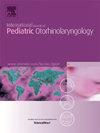Primary vs. secondary closure of tracheocutaneous fistulas: A prospective cohort study
IF 1.2
4区 医学
Q3 OTORHINOLARYNGOLOGY
International journal of pediatric otorhinolaryngology
Pub Date : 2025-02-26
DOI:10.1016/j.ijporl.2025.112293
引用次数: 0
Abstract
Objective
To prospectively compare outcomes and complications of the two most common techniques for closure of tracheocutaneous fistulas (TCFs): surgical excision of the tract with primary closure (PC), and de-epithelialization with healing by secondary intention (SI).
Study design
Prospective cohort study.
Setting
Tertiary academic center.
Methods
All patients who underwent closure of a TCF between 5/1/2022 and 5/30/2023 were eligible for inclusion in the study. Data was prospectively collected and included demographics, tracheostomy history, intraoperative data (including fistula size and closure technique), postoperative recovery and any complications.
Results
There were 15 patients who underwent PC, and 10 patients who underwent closure by SI. Both cohorts were premature and had tracheostomies for at least 2 years prior to decannulation. The length of time from decannulation to closure was longer in the primary vs secondary group (p = .01). The operative time was significantly longer in the PC group (p = .002) and the PC group experienced a significantly higher number of postoperative respiratory complications (p = .05) during their postoperative admission. The average TCF size was larger in the SI group compared to the PC group (p < 0.001).
Conclusion
This prospective study demonstrated fewer postoperative respiratory complications for SI closure of TCFs compared to PC.
气管皮瘘的原发性与继发性闭合:一项前瞻性队列研究
目的前瞻性比较两种最常见的气管皮瘘(tcf)治疗方法的结局和并发症:手术切除气管管束并一期闭合(PC)和上皮化去除并继发性愈合(SI)。研究设计前瞻性队列研究。高等教育学术中心。方法所有在2022年5月1日至2023年5月30日期间接受TCF关闭的患者均符合纳入研究的条件。前瞻性收集数据,包括人口统计学、气管造口术史、术中数据(包括瘘管大小和闭合技术)、术后恢复情况和任何并发症。结果15例患者行PC术,10例患者行SI缝合术。两组患者均为早产儿,在脱管前至少进行了2年的气管切开术。原发性组与继发性组相比,从脱管到闭合的时间更长(p = 0.01)。PC组手术时间明显长于PC组(p = 0.002), PC组术后呼吸系统并发症发生率明显高于PC组(p = 0.05)。SI组的平均TCF大小比PC组大(p <;0.001)。结论:该前瞻性研究表明,与PC相比,SI缝合tcf的术后呼吸并发症更少。
本文章由计算机程序翻译,如有差异,请以英文原文为准。
求助全文
约1分钟内获得全文
求助全文
来源期刊
CiteScore
3.20
自引率
6.70%
发文量
276
审稿时长
62 days
期刊介绍:
The purpose of the International Journal of Pediatric Otorhinolaryngology is to concentrate and disseminate information concerning prevention, cure and care of otorhinolaryngological disorders in infants and children due to developmental, degenerative, infectious, neoplastic, traumatic, social, psychiatric and economic causes. The Journal provides a medium for clinical and basic contributions in all of the areas of pediatric otorhinolaryngology. This includes medical and surgical otology, bronchoesophagology, laryngology, rhinology, diseases of the head and neck, and disorders of communication, including voice, speech and language disorders.

 求助内容:
求助内容: 应助结果提醒方式:
应助结果提醒方式:


